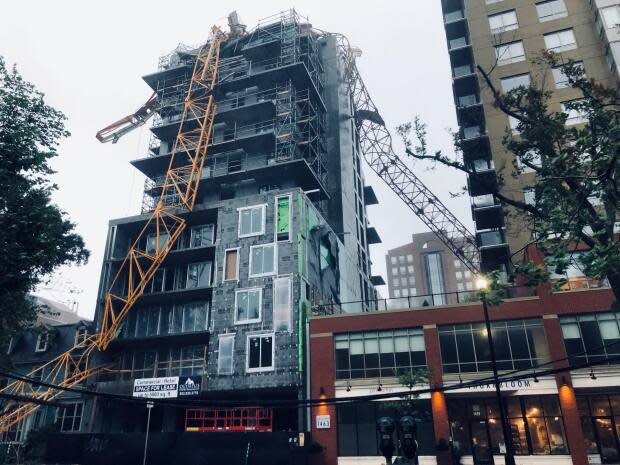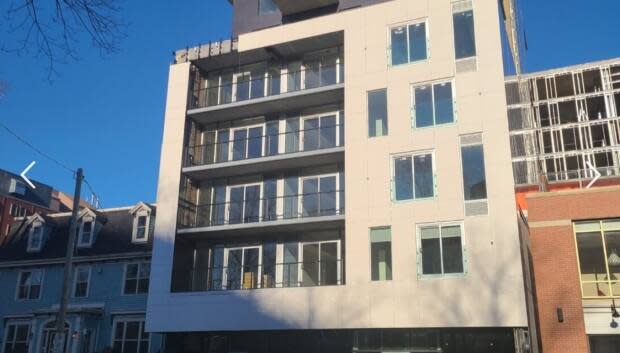Welding failure to blame for Halifax crane collapse during Dorian

A welding failure is likely to blame for the collapse of a crane in downtown Halifax during post-tropical storm Dorian, according to a new report from Nova Scotia's Labour Department.
In its investigation, the department's safety branch said a welded section about six to nine metres above the base of the mast became separated as the crane was pummelled by wind gusts as high as 107 km/h on Sept. 7, 2019.
The weld failure transferred "the weight supported by the mast's four vertical posts to only three of its posts, causing the tower section to rotate and fail, which resulted in the total collapse of the crane," said the report.
The crane, owned and operated by Lead Structural Formwork Ltd. of Moncton, N.B., toppled onto a 13-storey building under construction on South Park Street, causing significant damage to the top three levels.
A neighbouring building was also damaged when the crane struck the top corner and a balcony. Counterweights from the tower crane fell to the street.
Localized state of emergency
No one was injured in the collapse, but the surrounding area — a mix of homes and businesses — had to be evacuated. Some businesses were forced to stay closed when their entrances became inaccessible, losing out on considerable revenue.
The provincial government issued a localized state of emergency, saying the measure was necessary to ensure the swift and safe removal of the crane. The province covered the $2-million bill in an attempt to get the work done as soon as possible and the area reopened to the public.
Work to safely remove the tower crane and debris from the building was completed on Nov. 4, 2019.
Cranes meant to withstand stronger gusts
The report said the fallen crane was a Manitowoc model Potain 8520Ps. Generally, tower cranes are designed to sustain winds of 150-160 km/h. On the day of the storm, winds were recorded to be much lower with wind gusts of 97-107 km/h.
On June 4, 2019, the province's safety branch was advised by the general contractor that the turntable at the top of the tower crane had seized, preventing it from "weather vaning" — basically rotating freely in the wind when not in use.
The contractor informed the province that the top section of the crane, consisting of the cabin, turntable and jib, would be repaired or replaced as soon as possible to deal with the inability to rotate freely. The repair was made June 7, 2019.
Crane operator met requirements
The investigation determined Lead Structural Formwork met the legislative and regulatory requirements to prevent the event from happening and no further action would be taken with regard to the collapse.

The province said recently the Department of Labour would meet with all tower crane owners and operators in the province, and require that all crane masts be thoroughly cleaned, inspected and tested to identify any defects or potential deterioration.
Several businesses that were affected by the collapse have launched a proposed class-action lawsuit against WM Fares Architects Inc. and WM Fares & Associates Incorporated, the developer of the building that was under construction when the crane toppled, in an effort to recover lost sales. The lawsuit also names Lead Structural Formwork and the Manitowoc Company.
MORE TOP STORIES

 Yahoo Movies
Yahoo Movies 